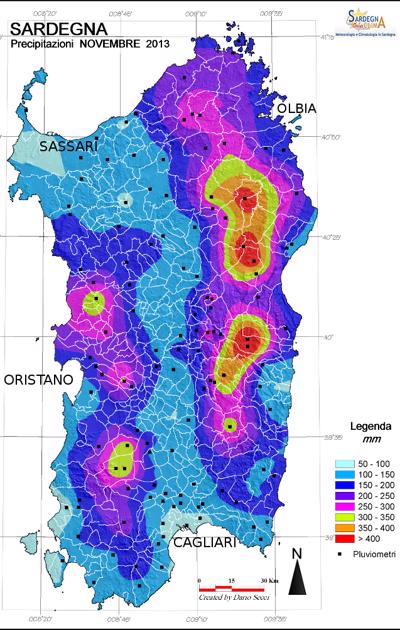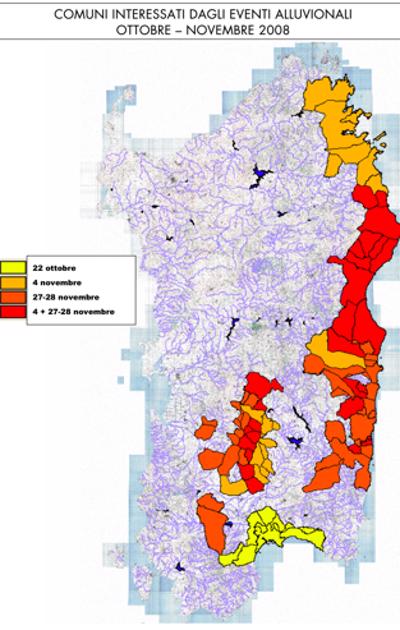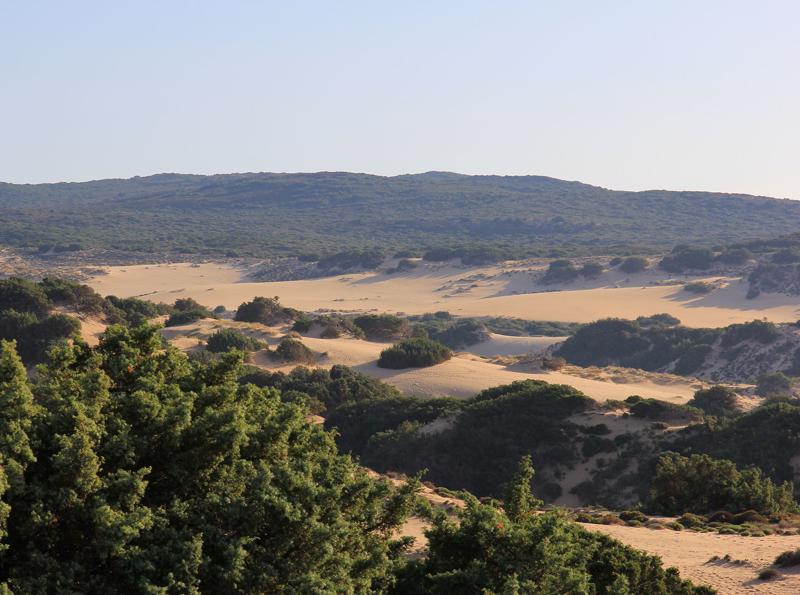My diary
Among all the positive qualities of Sardinia, being hazard-free is not included. From a geological point of view, the region is very old – dated around half billion years ago – and therefore very stable, without any evident risk of earthquake; same thing being true for tsunamis, hurricanes and similar. If instead we are talking about natural hazards heavily influenced by human activities, well, all the world is plenty of them and Sardinia is not an exception. In particular, the three hazards that most affect my region are in order: floods, draught and wild fires.
1) Floods
Sardinia is not famous for its fluvial waters not for its raining – but there is a period of the year, around September-October, in which a bit more rain than the usual creates a big mess. It happens especially in areas near the coast that are crossed by (usually man-made) canals not big enough to contain all the extra water, as in the case of the cities of Cagliari and Olbia. The last two big floods happened in 2008 in Cagliari and in 2013 in Olbia causing wide damages. I remember in 2008 being stuck at school because of the flood, my mother couldn’t pick me up, while cars were floating outside the window. Of course, while the big cities managed in some ways to recover, the surrounding small towns were the ones most affected from an economic point of view – fortunately, a great community net was put in place and with the help of local people, artists and the government we had been able to rebuild those areas affected.
2) Draught and hot temperatures
Climate change is a big deal all over the world and even if pollution is still not one of the major problem in Sardinia, draught is. In summer the average maximum temperature is around 35°C, reaching the 40°es in the South-East, South-West and North-West of the island – where you can find an almost desertic landscape. Also flat lands far from water resources are especially exposed to this phenomenon, and prolonged period without a single drop of water do not help at all. Elderlies, children and farmers in general are the most vulnerable: the latter every year loose around 300€ million between completely dry fields and dying breeding. It is worth noticing however that, at least in Sardinia, starting from 2017 a sum of 45€ million have been allocated for reorganizing and improving the water usage: ‘drop-by-drop’ irrigation and a more efficient water recycle system
lucagambelli1505
15 chapters
16 Apr 2020
Day Two: Hazards in Sardinia
April 03, 2019
Among all the positive qualities of Sardinia, being hazard-free is not included. From a geological point of view, the region is very old – dated around half billion years ago – and therefore very stable, without any evident risk of earthquake; same thing being true for tsunamis, hurricanes and similar. If instead we are talking about natural hazards heavily influenced by human activities, well, all the world is plenty of them and Sardinia is not an exception. In particular, the three hazards that most affect my region are in order: floods, draught and wild fires.
1) Floods
Sardinia is not famous for its fluvial waters not for its raining – but there is a period of the year, around September-October, in which a bit more rain than the usual creates a big mess. It happens especially in areas near the coast that are crossed by (usually man-made) canals not big enough to contain all the extra water, as in the case of the cities of Cagliari and Olbia. The last two big floods happened in 2008 in Cagliari and in 2013 in Olbia causing wide damages. I remember in 2008 being stuck at school because of the flood, my mother couldn’t pick me up, while cars were floating outside the window. Of course, while the big cities managed in some ways to recover, the surrounding small towns were the ones most affected from an economic point of view – fortunately, a great community net was put in place and with the help of local people, artists and the government we had been able to rebuild those areas affected.
2) Draught and hot temperatures
Climate change is a big deal all over the world and even if pollution is still not one of the major problem in Sardinia, draught is. In summer the average maximum temperature is around 35°C, reaching the 40°es in the South-East, South-West and North-West of the island – where you can find an almost desertic landscape. Also flat lands far from water resources are especially exposed to this phenomenon, and prolonged period without a single drop of water do not help at all. Elderlies, children and farmers in general are the most vulnerable: the latter every year loose around 300€ million between completely dry fields and dying breeding. It is worth noticing however that, at least in Sardinia, starting from 2017 a sum of 45€ million have been allocated for reorganizing and improving the water usage: ‘drop-by-drop’ irrigation and a more efficient water recycle system


are the top priorities.
3) Wild fires
Another nice hazard that regularly hits Sardinia in summer is wild fire. Of course, the majority of fires taking place in the region have a human nature… but still, due to the high temperatures, around 7 million hectares are destroyed every year by flames. No particular area in the region is safe from the hazard, being covered by forests and cultivated fields all over the territory, but the central areas far from water resources are once again the most affected. Of course a big role is played by the wind and its direction, according to which the fire can reach different intensities and take different directions. The highest vulnerable subjects of such risk are all those small towns in the inland surrounded by woods and the cultivated lands of farmers, but also touristic villages alongside the coast most of the times have to endure the damages.

1.
Day One: New Possibilities
2.
Day Two: Hazards in Sardinia
3.
Day Three: 2016 Louisiana Flood
4.
Day Four: Resilience and Structural Changes
5.
Day Five: the Development Loop Theory
6.
Day Six: New Inclusive Growth
7.
Day Seven: Culture and Different Perspectives
8.
Day Eight: Social Safety Nets
9.
Day Nine: Swimming Competitions
10.
Day Ten: Viruses and Vaccines
11.
Day Eleven: the Psychology of Reactions
12.
Day Twelve: Outrage
13.
Day Thirdteen: a Recovery to Migration?
14.
Day Forteen: Building back Communities
15.
Day Fifteen: the Final Choice
Share your travel adventures like this!
Create your own travel blog in one step
Share with friends and family to follow your journey
Easy set up, no technical knowledge needed and unlimited storage!